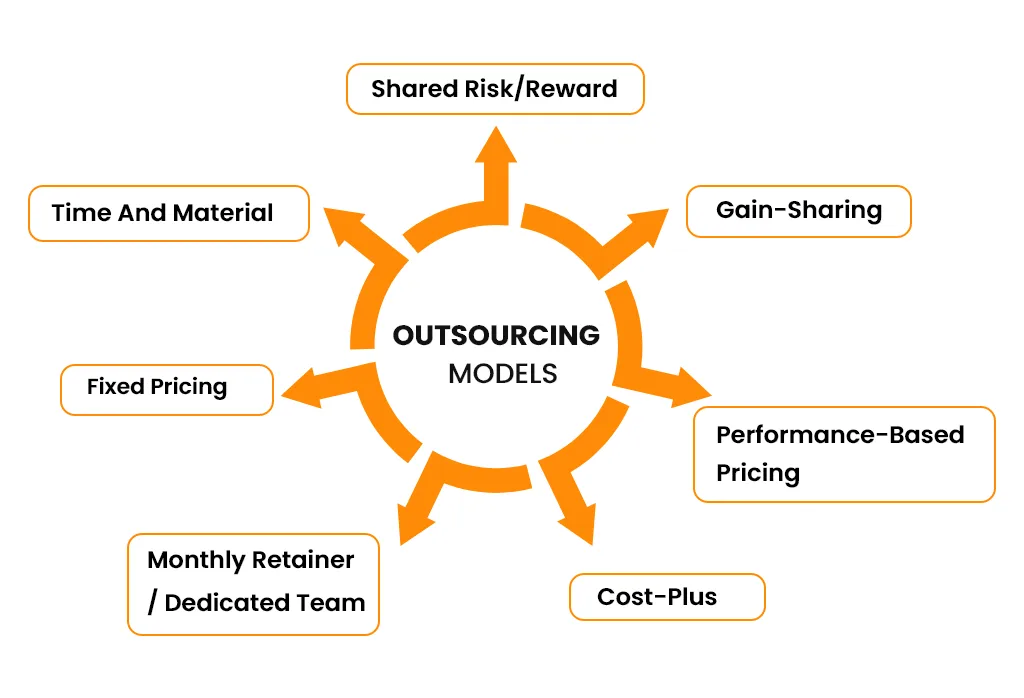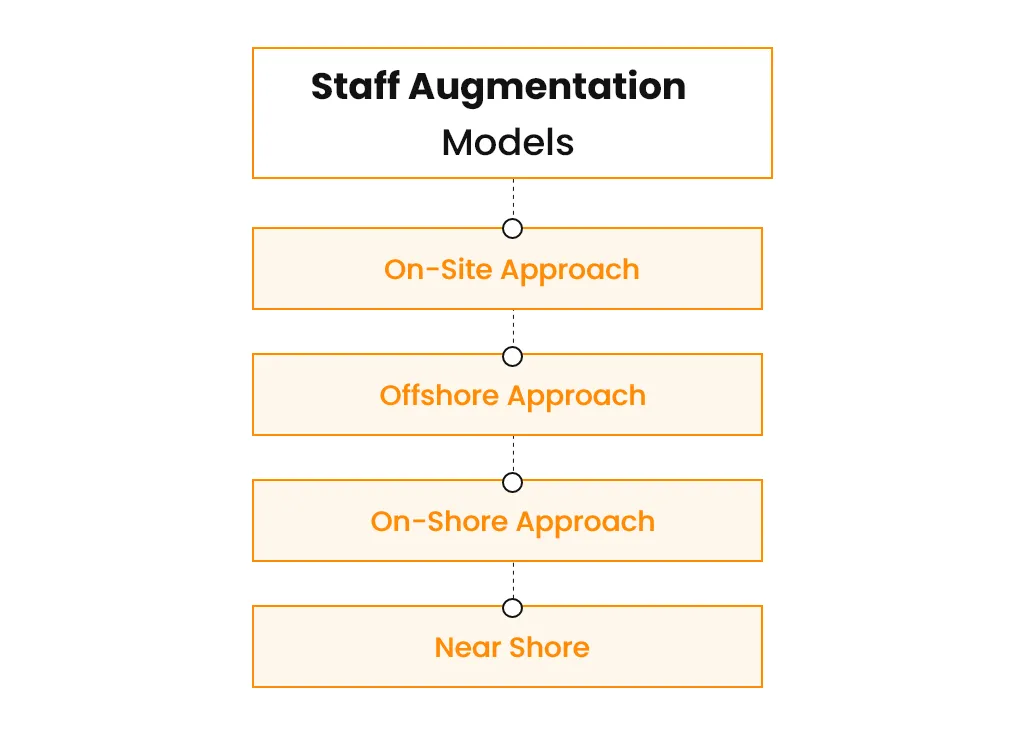Staff Augmentation Vs Outsourcing – What’s Working in 2022

Staff augmentation vs outsourcing – which model of remote work is most suitable for us? It’s something every tech leader has to decide when faced with bottlenecks that throttle their speed to market.
But it’s not that simple. With a wide range of options available, tech leaders need to make the right decision so they can achieve their goals within the timeline and budgets determined.
We have created a detailed analysis of staff augmentation vs outsourcing, the different models of each, pros and cons, and how to decide the best strategy for your business.
Table of Contents
Chapter – 1: Staff Augmentation vs Outsourcing: An Introduction
What is Outsourcing?
To put it plainly, outsourcing is when a company hires the services of a third-party organization to perform tasks that could be handled in-house. These services could be related to manufacturing, marketing, web development, etc. Outsourcing has different models of its own, which we’ll go through in a while.
What is Staff Augmentation?
Staff augmentation is when you hire resources from another organization to augment the capacity of your internal team. The resources you hire will be on the payroll of the service provider but will become a part of your team – let’s say an extended team.
While many people consider staff augmentation as an outsourcing model, there are some key differences that clearly draw a line between them.
Also Read: What Is Staff Augmentation and Its 6 Key Benefits
Examples of Staff Augmentation vs Outsourcing
Say you are someone running a technology company and you have started a new project that will take a year or so to develop.
There can be a few scenarios here, which will determine what option you choose: staff augmentation or outsourcing.
Scenario 1: You don’t already have a development team to tackle this project. You need a whole team consisting of Developers with different skillsets, Project Managers, QA analysts, and IT Operations to develop, test, and deploy the project. In this case, outsourcing the project may be your best bet.
Plus, it’s not just the different roles you need for your project’s development – you also need to develop processes and invest in the right tools to get it going smoothly. A software project is doomed to failure if the right processes and tools are not used. The company you outsource to will have all those roles in their team, a mature process plus a solid toolchain to facilitate development.
Scenario 2: You do have a development team but your team lacks some skillsets or roles that are essential to speed up the development of your project.
In this case, you have two options: open those missing positions and recruit those roles in-house. Or work with a staff augmentation provider and hire those missing roles from them on a yearly contractual basis.
Hiring in-house comes with its own set of problems. And when you know the project is going to end next year, what are you going to do with those developers then? Lay them off? In this case, staff augmentation is the ideal solution as you can get highly skilled resources for the amount of time you require.
Chapter – 2: Staff Augmentation vs Outsourcing – How Do They Work Differently?
Let’s dive into the nitty-gritty and see how these models work differently.
Outsourcing – The Process

It all begins with Discovery – the first phase in which we try to gather as much information about the project as possible. Armed with all that information, we advise the client on the most suitable engagement model for them.
The rest of the process depends on the engagement model we determine. For example, if the client decides to do a fixed-price project, the next phase would be to scope out the project thoroughly and quote a fixed price.
If the client decides on a Time and Material model, the project is handed off to the project manager following a high-level scoping.
No matter which engagement model is used, the project is developed using different agile methodologies. At Codup, we use kanban and scrum to ensure projects are delivered on time and within budget.
Outsourcing – Different Models

Time And Material
In Time and Material engagement model, the client only pays for the time and resources spent on the project. This type of model is most suitable for agile development.
In T&M, the scope isn’t normally defined. Different resources are being engaged on different tasks and the client is billed based on the time and resources spent.
Here, it’s possible that 2 developers with different experience levels are being engaged simultaneously on the project. The hourly rate charged for these 2 resources will, therefore, be different.
Fixed Pricing
If a company knows its requirements well and understands that the requirements will stay the same from the start till the end of the project, then the fixed price model is the best choice for them. In this model, a fixed price is quoted before beginning the project. The scope of the project is well-defined and as the name suggests, the price remains fixed as far as there are no changes in the scope. If the client requests new features, the project goes back to the discovery phase and the scope and price is revised.
Monthly Retainer/ Dedicated Team
In a monthly retainer, the client pays a fixed monthly fee in exchange for a fixed number of hours. This model is best for clients who have ongoing requirements and need dedicated resources to support them.
Cost-Plus
In this model, the client and the service provider determine and agree upon the cost of the project. The service provider then adds their profit into the cost of the project. Hence called the Cost-Plus model, which refers to cost plus profit.
Performance-Based Pricing
The performance-based pricing model is based on traditional models – usually fixed price or time and material. But things get a little interesting here as the client may reward or penalize the contractor based on their level of performance.
Gain-Sharing
This model of outsourcing is based on the value-added by the service provider through their contribution or expertise. Both stand to gain from this model, based on the performance of the service provider. Therefore, the service provider is usually seen to perform at their best.
Shared Risk/Reward
The client and contractor both get in on the game for a limited period. Both the parties have skin in the game and stand to either lose or win all. This model sounds a lot like a joint venture.
Staff Augmentation – The Process
A Staff Augmentation project begins with the client sending their requirements for the type of resource they need. The service provider finds the best match for them – either from their bench or their talent pool and forwards the CV to the client. If the client approves, an interview is scheduled and the resource is onboarded in the following days.

Staff Augmentation – Different Models

On-Site Approach
In the on-site approach, a company usually brings in the augmented staff in their workspace. This requires the company to arrange and provide the necessary infrastructure and all other work-related facilities to the augmented staff, that they require for working on the project.
On-Shore Approach
On-shore approach, as the name suggests, refers to a company bringing in augmented staff from an organization operating in the same country. Using this approach for staff augmentation helps companies avoid issues such as time zone differences, language barriers, and cultural differences. However, augmenting staff from the same country means that the company has to pay standard hourly rates, which can be a little costly.
Near Shore
Nearshore approach is when a company brings in augmented staff in their teams from nearby countries (neighboring countries). This helps minimize cultural differences, language, and time zone barriers. However, nearshoring can be relatively costly as compared to offshoring.
Offshore
In offshoring, the company providing staff augmentation services is situated in a different country. This helps save costs. However, cultural differences, language barriers, and time zone differences may be a challenge to deal with.
Chapter – 3: Staff Augmentation vs Outsourcing – The Pros and Cons
Let’s explore the benefits and drawbacks of both strategies, which will help you make the right decision.
Outsourcing: Pros & Cons
| Pros | Cons |
|---|---|
| Cost Savings: Outsourcing gives obvious cost savings by not having to build and manage an in-house team, and develop infrastructure to support the team. | Time Consuming Deal Signing Process Legal formalities and contract signing may take up a lot of time. |
| Increase Speed to Market: Outsourcing the project to experts helps you complete the project faster and gain the first-mover advantage. | Internal Resistance In-house employees may feel uncomfortable working alongside an outsourcing agency. |
| Increased Focus on Core Operations With outsourcing, you can focus more on your core competencies helping you increase productivity and improve results. | Communication Barriers Outsourcing to offshore companies may result in language barriers, resulting in ineffective communication. |
| Decrease in Employee Training Costs When outsourcing, you don’t have the responsibility of training and developing the skills of employees, which helps in cutting down the training costs. | Different Time Zones The difference in time zone may lead to longer response times, leading to frustrations. |
| Change in Cost Structure With outsourcing, your costs vary according to the project rather than having fixed costs of employing human resources. | Less Control The project is managed by the outsourcing agency and the client has no control over internal processes. |
Staff Augmentation: Pros & Cons
| Pros | Cons |
|---|---|
| Flexibility in scaling up and down Staff augmentation is flexible because a company can easily hire employees only for the duration of a project. | Bound by Contract If your projects are finished earlier than anticipated, you’ll still be bound by the contract. |
| Hassle-Free Recruitment Staff augmentation allows you to avoid time-consuming and expensive recruitment processes. | Additional Ramp up Time Your augmented staff may require additional time to build context on the project. |
| Cost-Effective It’s more cost-effective to augment your team for short-term projects rather than hiring someone on a permanent basis. | Additional Training Time Since every company has different tools and work processes, your augmented staff may require some additional training to have a better understanding of your company’s tools and processes. |
| Access to Specialized Resources Sometimes you need very niche skills to fill the skill gaps in your team. Staff augmentation gives you that leverage. | Communication Barriers Timezone differences and language barriers can be troublesome if nothing’s done to overcome this problem. |
| Complete Control Because you are managing the augmented staff, you have more control over the day-to-day operations. | |
| Seamless Integration with In-house Team Employees don’t feel threatened when the augmented staff becomes a part of the internal team, as compared to outsourcing, where the entire project is outsourced to another company. |
Chapter – 4: Staff Augmentation Vs Outsourcing – What Will Work for Your Business?
When outsourcing, the project is completely handed over to the service provider with all its operational responsibilities. The outsourced team manages the whole project through to delivery. The team engaged in your project will include personnel with different skill sets and roles – project managers, developers, QA analysts, and IT operations.
With staff augmentation, on the other hand, you’ll have full control of your resources and you will be the one to manage all operational responsibilities for the said project.
So, what’s going to work for your business? This completely depends on your business needs and the size of your project. If you have experience developing projects in the past and have already developed processes and built a team in-house, staff augmentation may be the right answer for you. Keep in mind that a successful project not only requires programming expertise but requires well-developed processes and familiarity with tools as well. Hence, if your business needs help for a one-time project, outsourcing would be a better option.
| Requirements/Scenarios | Outsourcing | Staff Augmentation |
| Need full control | Yes | |
| Already have internal processes | Yes | |
| Already have an IT department and development team | Yes | |
| Filling gaps in your team and adding specialized skillsets | Yes | |
| Need help for a one-time project | Yes | |
| Haven’t developed any project management processes and invested in productivity tools | Yes | |
| Facing difficulty in retaining tech talent | Yes | Yes |
| Don’t have expertise in industry best practices | Yes | |
| Staying focused on core business | Yes |
Need help with a project? Get in touch with us and we’ll advise you on the best engagement model for your business.



